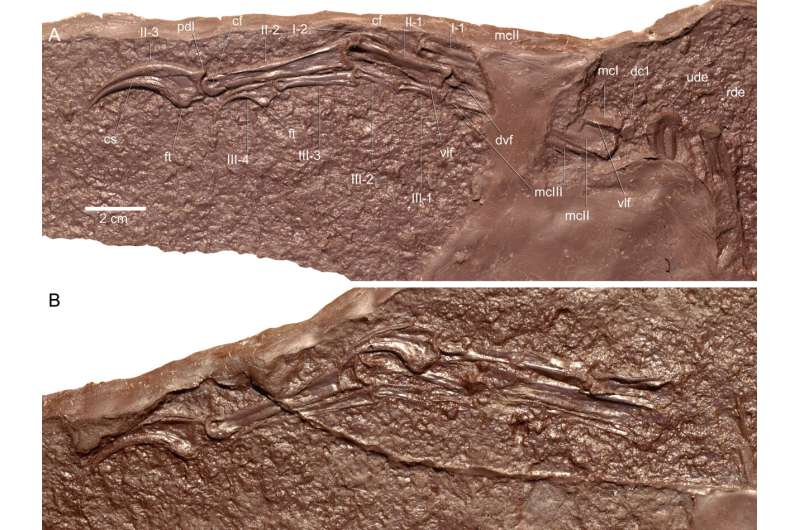June 22, 2023 report
This article has been reviewed according to Science X's editorial process and policies. Editors have highlighted the following attributes while ensuring the content's credibility:
fact-checked
peer-reviewed publication
trusted source
proofread
Newly identified theropod dinosaur had strange hands

A team of archaeologists and paleontologists affiliated with several institutions in China, working with a colleague from Italy, has identified a new species of theropod dinosaur with strange hand features. In their paper published in the journal Cretaceous Research, the group describes the creature and where it fits evolutionarily with other dinosaurs.
The fossil was found at the Pigeon Hill dig site near the town of Baoshan in Inner Mongolia, China. It was completely embedded in a slab of rock, allowing the researchers a view from the side only. Still, that was enough to reveal that the dinosaur fossil represented a new species of theropod. Dating of the fossil put the dinosaur in the Early Cretaceous epoch, approximately 121 million years ago.
The newly discovered dinosaur has been named Migmanychion laiyang—examination of its bone structure showed it to be a member of Maniraptora, from the group of coelurosaurian dinosaurs, some of which evolved to become modern birds. The group is believed to have first appeared during the Jurassic and is part of a broader clade that includes both Tyrannosaurus rex and allosaurus. Most have long arms and hands with three fingers, along with a uniquely moon-shaped bone in the wrist. Maniraptorans are the only group of dinosaurs that include those that fly.
The fossil is incomplete, preserving only one complete hand, some ribs and a left forelimb. But it reveals a never-before-seen species of theropod with a unique hand structure different from all other known theropods. They suggest its structure is somewhat similar to members of the oviraptorosaurs and therizinosauroids (whose most famous member is the huge pot-bellied Therizinosaurus). Notably, oviraptors are known for their feathers, bird-like skulls and omnivorous diet.
The researchers suggest that M. laiyang is also reminiscent of Fukuivenator paradoxus, which has been found in what is now Japan. They conclude that M. laiyang likely evolved separately from linages that led to modern birds. They plan to continue looking for more examples to more accurately classify the new species.
More information: Xuri Wang et al, A new theropod dinosaur from the Lower Cretaceous Longjiang Formation of Inner Mongolia (China), Cretaceous Research (2023). DOI: 10.1016/j.cretres.2023.105605
Journal information: Cretaceous Research
© 2023 Science X Network





















